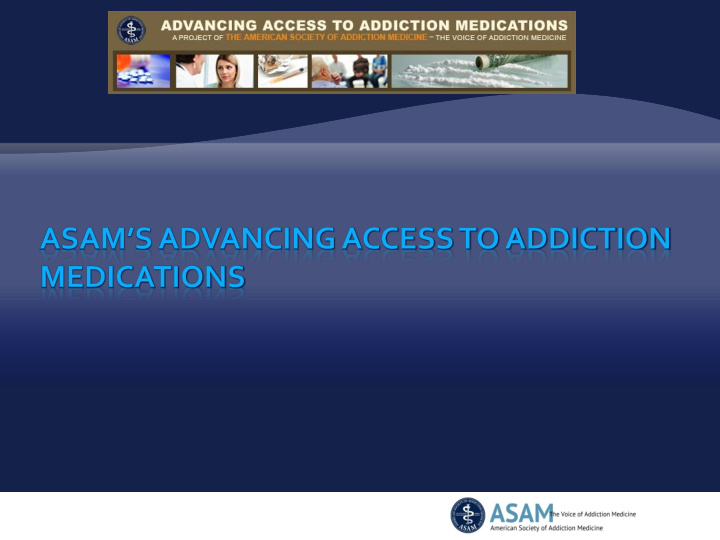



Professional society founded in 1954 representing 3,100+ physicians & other associated professionals Mission: Increase access to & improve the quality of addiction treatment Educate physicians, other health care providers & public Support research & prevention Promote appropriate role of the physician in patient care Establish addiction medicine as a recognized specialty
April 2012: May 2011: ASAM Board of June 20, 2013: October 23, 2013: Dr. Mark Publicker, Directors appointed a September 30, 2013: an ASAM addiction Patient Advocacy PATF Stakeholder ASAM Legislative specialist physician, Task Force (PATF) to Summit at The ASAM Hill Briefing Day on Capitol Hill; alerted ASAM to advocate for patient National Press Club on pharmacotherapy ASAM members Maine legislation access to evidence- in Washington, DC; for opioid addiction bring awareness of that limits patient based, cost-effective Report results are treatment. the issue to access to addiction medication disseminated. policymakers. medications. treatment for opioid dependence.
State Medicaid survey of coverage & access Commercial insurer survey of coverage & access Literature reviews of clinical and cost effectiveness of medications to treat opioid addiction TRI and Avisa Group retained to do research Available on ASAM website (www.asam.org)
Every state Medicaid program covers at least one of the FDA-approved medications Many state Medicaid programs have implemented a variety of authorization requirements which must be met in order for payment for these medications to be approved Requirements for approval can range from limited to severe, and may include “fail first” policies or a history of frequent service utilization
Inclusion in a plan’s formulary does not equate to easy access Utilization management (UM) can reduce access Most common UM requirements are: Prior authorization Quantity and dosage limits Step therapy or “fail first” requirements
Most widely available is Suboxone & new formulations may make it even more available Generic formulation approved by the FDA in March, 2013 is already available in about 50% of plans studied While methadone is available in Opioid Treatment Programs (OTPs) study found no commercial coverage
All medications are FDA approved (methadone*) Hundreds of effectiveness studies All medications have demonstrated modest or better cost effectiveness in maintenance No evidence for effectiveness in detoxification All medications are under-utilized – many reasons
Create briefs and toolkit from research for use by all for local outreach – especially as state legislatures meet in early 2014 Build and train speakers bureau Plan for 2014 national outreach day Develop national practice guideline
Stay tuned for next steps All reports are available online at http://www.asam.org/docs/advocacy/Implication s-for-Opioid-Addiction-Treatment
Recommend
More recommend